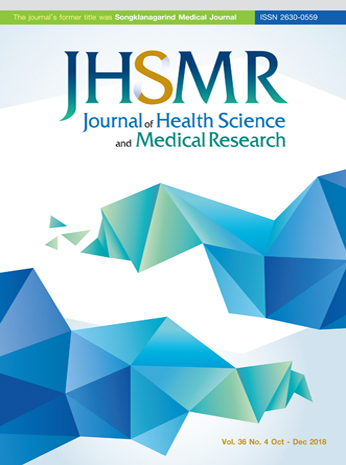A Study on the Comparison of Burnout Syndrome, Among Medical Doctors in the Restive Areas and Non-Restive Areas of the South Thailand Insurgency
DOI:
https://doi.org/10.31584/jhsmr.201825Keywords:
burnout, medical doctor, south Thailand insurgencyAbstract
Objective: This study aims to compare burnout syndrome as well as the associated factors among doctors, who work at, secondary and tertiary-care hospitals either: in the restive areas of Thailand’s southern insurgency, and the nonrestive areas of nearby provinces.
Material and Methods: This was a cross-sectional designed study, which was conducted in order to survey all doctors, who worked at hospitals, located in lower, southern Thailand from; January to April 2018. The questionnaire used; The Maslach Burnout Inventory (MBI) Thai version questionnaire. The data was analyzed by descriptive statistics. The factors associated with burnout syndrome were analyzed by using chi-square test and logistic regression.
Results: The total number of participants were; 245 medical doctors. Fifty-eight percent of them were females, whilst 42.0% were males, and most of them were single (50.2%). The mean age of the participants was; 35.9 years, and 30.2% of them worked more than 40 hours per week. The total prevalence of Burnout syndrome among them was; 99.6%, with the highest score found to be in the emotional exhaustion section. There were no differences in burnout syndrome between, those who worked in restive areas and those who worked in non-restive areas of Thailand’s southern insurgency, grade point average (GPA), perceived sleep/rest quality and perceived work stress were related to emotional exhaustion, while types of specialty, work hour/week and family relationships were associated with depersonalization. The sample size was not adequate for the personal accomplishment part analysis.
Conclusion: Almost all medical doctors, who worked at either secondary or tertiary-care hospitals in the lower, southern areas of Thailand, suffered from burnout, only 1 physician did not. The factors associated to burnout syndrome are; work hours per week, GPA, type of specialty, perception of sleeping/rest quality, perception of having stress from work and family relationships.
References
2. Garcia-Arroyo JM, Dominguez-Lopez ML. Subjective aspects of burnout syndrome in the medical profession. PSYCH 2014;5:2064-72.
3. Maslach C, Jackson S. Burnout in health professions: a social psychological analysis. In: Sanders G, Suls J, editors. Social psychology of health and illness. New Jersey: Lawrence Erlbaum; 1982;p.227-51.
4. Krakowski AJ. Stress and the practice of medicine-the myth and reality. J Psychosom Res 1982;26:91-8.
5. Cherniss C. Long-term consequences of burnout: an exploration study. J Organ Behav 1992;13:1-11.
6. Leiter MP. Coping patterns as predictors of burnout: the function of control and escaist coping patterns. J Organ Behav 1991;12:123-44.
7. Greenglass ER, Burke RJ, Konarski R. Component of burnout, resources and gender-related differences. J Appl Soc Psychol 1998;28:1088-106.
8. Aiken LH, Clarke SP, Sloane DM, Sochalski J, Silber JH. Hospital nurse staffing and patient mortality, nurse burnout and job dissatisfaction. JAMA 2002;288:1987-93.
9. PPTVHD 36. Medical information as at 31 December 2015 [homepage on the Internet]. Bangkok: PPTVHD 36; 2015
[cited 2017 Jun 6]. Available from: https://www.pptvhd36.com/news/hot issue/18849
10. The Medical Council of Thailand. Medical statistic [homepage on the Internet]. Nonthaburi: The Medical Council of Thailand; 2017 [cited 2017 Jun 6]. Available from: https://www.tmc.or.th/statistics.php
11. Lerthattasilp T. Burnout among psychiatrists in Thailand: National survey. J Psychiatr Assoc Thailand 2011;56:437-48.
12. Charoenwong S, Kongsuwan V, Taogani M. Stress and psychological self-care behaviors of the people in the unrest area of Narathiwat Province, Thailand. Bangkok: Mental Health in the City; 2007.
13. Ministry of Public Health, Thailand. 12nd health region’s personnel information [homepage on the Internet]. Nonthaburi: The Ministry; 2017 [cited 2017 Aug 5]. Available from: https://www.sasuk12.com/pdf/CHRO_27Oct2016.pdf
14. Yamane T. Statistics; an introductory analysis. 2nd ed. New York: Harper and Row; 1967.
15. Maslash C, Jackson SE. The measurement of experienced burnout. J Occup Behav 1981;2:99-113.
16. Maslach C, Schaufeli WB, Leiter MP. Job burnout. Annu Rev Psychol 2001;52:397-422.
17. Jareonsettasin T. Health systems reform in England history of NHS in England [homepage on the Internet]. Bangkok: Health Systems Research Institute (HSRI); 2001 [cited 2018 May 15]. Available from: https://kb.hsri.or.th/dspace/handle/11228/1744?locale-attribute=th
18. Arigoni F, Bovier PA, Mermillod B, Waltz P, Sappino AP. Prevalence of burnout among Swiss cancer clinicians, paediatricians and general practitioners: who are most at risk?. Support Care Cancer 2009;17:75-81.
19. Shapiro SL, Shapiro DE, Schwartz GE. Stress management in medical education: a review of the literature. Acad Med 2000;75:748-59.
20. United States Department of Labor. Work hours [homepage on the Internet]. Washington: United States Department of Labor; 2018 [cited 2018 May 22]. Available from: https://www.dol.gov/general/topic/workhours
21. Staiger DO, Auerbach DI, Buerhaus PI. Trends in the work hours of physicians in the United States. JAMA 2010;303:747-53.























